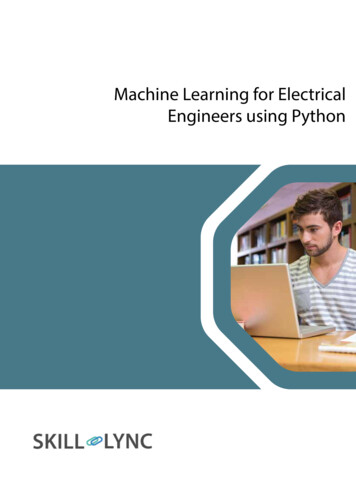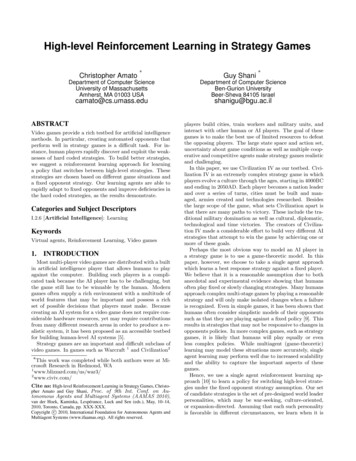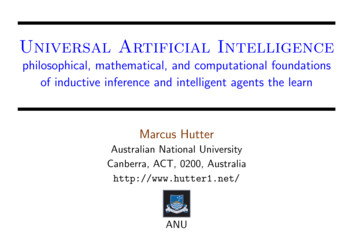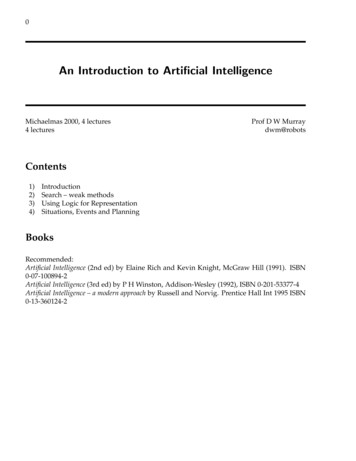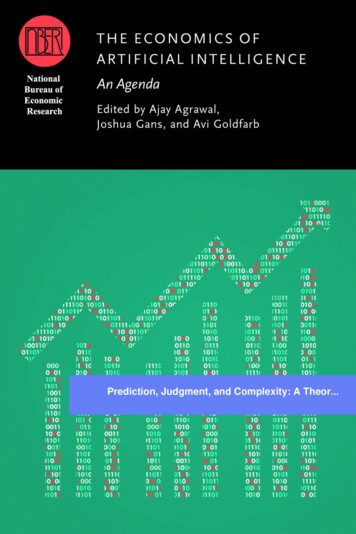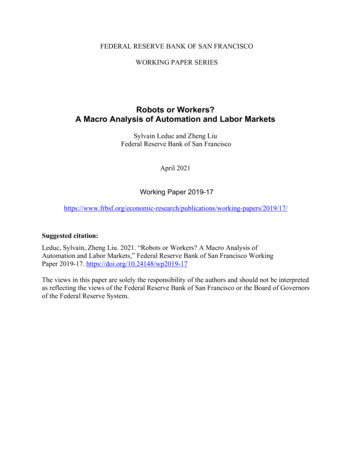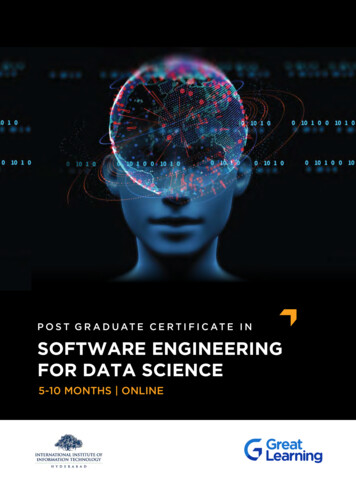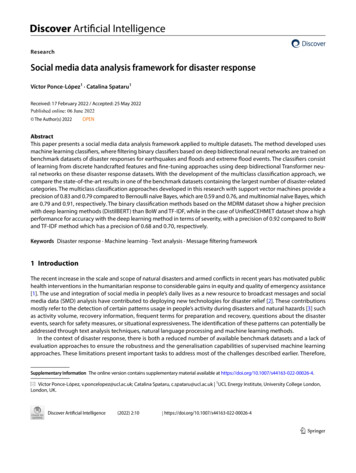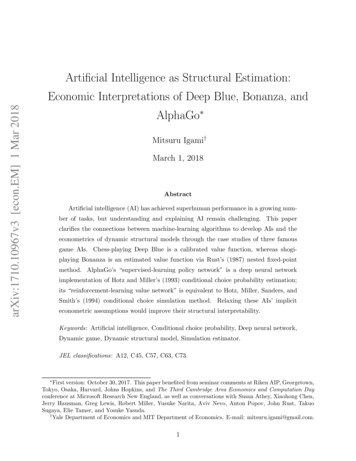
Transcription
Artificial Intelligence as Structural Estimation:arXiv:1710.10967v3 [econ.EM] 1 Mar 2018Economic Interpretations of Deep Blue, Bonanza, andAlphaGo Mitsuru Igami†March 1, 2018AbstractArtificial intelligence (AI) has achieved superhuman performance in a growing number of tasks, but understanding and explaining AI remain challenging. This paperclarifies the connections between machine-learning algorithms to develop AIs and theeconometrics of dynamic structural models through the case studies of three famousgame AIs. Chess-playing Deep Blue is a calibrated value function, whereas shogiplaying Bonanza is an estimated value function via Rust’s (1987) nested fixed-pointmethod. AlphaGo’s “supervised-learning policy network” is a deep neural networkimplementation of Hotz and Miller’s (1993) conditional choice probability estimation;its “reinforcement-learning value network” is equivalent to Hotz, Miller, Sanders, andSmith’s (1994) conditional choice simulation method. Relaxing these AIs’ impliciteconometric assumptions would improve their structural interpretability.Keywords: Artificial intelligence, Conditional choice probability, Deep neural network,Dynamic game, Dynamic structural model, Simulation estimator.JEL classifications: A12, C45, C57, C63, C73. First version: October 30, 2017. This paper benefited from seminar comments at Riken AIP, Georgetown,Tokyo, Osaka, Harvard, Johns Hopkins, and The Third Cambridge Area Economics and Computation Dayconference at Microsoft Research New England, as well as conversations with Susan Athey, Xiaohong Chen,Jerry Hausman, Greg Lewis, Robert Miller, Yusuke Narita, Aviv Nevo, Anton Popov, John Rust, TakuoSugaya, Elie Tamer, and Yosuke Yasuda.†Yale Department of Economics and MIT Department of Economics. E-mail: mitsuru.igami@gmail.com.1
1IntroductionArtificial intelligence (AI) has achieved human-like performance in a growing number oftasks, such as visual recognition and natural language processing.1 The classical gamesof chess, shogi (Japanese chess), and Go were once thought to be too complicated andintractable for AI, but computer scientists have overcome these challenges. In chess, IBM’scomputer system named Deep Blue defeated Grandmaster Garry Kasparov in 1997. In shogi,a machine-learning-based program called Bonanza challenged (and was defeated by) Ryūōchampion Akira Watanabe in 2007, but one of its successors (Ponanza) played against Meijinchampion Amahiko Satoh and won in 2017. In Go, Google DeepMind developed AlphaGo,a deep-learning-based program, which beat the 2-dan European champion Fan Hui in 2015,a 9-dan (highest rank) professional Lee Sedol in 2016, and the world’s best player Ke Jie in2017.Despite such remarkable achievements, one of the lingering criticisms of AI is its lackof transparency. The internal mechanism seems like a black box to most people, includingthe human experts of the relevant tasks,2 which raises concerns about accountability andresponsibility. The desire to understand and explain the functioning of AI is not limited tothe scientific community. For example, the US Department of Defense airs its concern that“the effectiveness of these systems is limited by the machine’s current inability to explaintheir decisions and actions to human users,” which led it to host the Explainable AI (XAI)program aimed at developing “understandable” and “trustworthy” machine learning.3This paper examines three prominent game AIs in recent history: Deep Blue, Bonanza,and AlphaGo. I have chosen to study this category of AIs because board games represent anarchetypical task that has required human intelligence, including cognitive skills, decisionmaking, and problem-solving. They are also well-defined problems for which economic interpretations are more natural than for, say, visual recognition and natural language processing.The main finding from this paper’s case studies is that these AIs’ key components are mathematically equivalent to well-known econometric methods to estimate dynamic structuralmodels.Chess experts and IBM’s engineers manually adjusted thousands of parameters in Deep1The formal definition of AI seems contentious, partly because scholars have not agreed on the definitionof intelligence in the first place. This paper follows a broad definition of AI as computer systems able toperform tasks that traditionally required human intelligence.2For example, Yoshiharu Habu, the strongest shogi player in recent history, states he does not understandcertain board-evaluation functions of computer shogi programs (Habu and NHK [2017]).3See al-intelligence (accessed on October 17, 2017).2
Blue’s “evaluation function,” which quantifies the probability of eventual winning as a function of the current positions of pieces (i.e., state of the game) and therefore could be interpreted as an approximate value function. Deep Blue is a calibrated value function with alinear functional form.By contrast, the developer of Bonanza constructed a dataset of professional shogi games,and used a discrete-choice regression and a backward-induction algorithm to determine theparameters of its value function. Hence, his method of “supervised learning” is equivalent toRust’s (1987) nested fixed-point (NFXP) algorithm, which combined a discrete-choice modelwith dynamic programming (DP) in the maximum likelihood estimation (MLE) framework.Bonanza is an empirical model of human shogi players that is estimated by this direct (or“full-solution”) method.Google DeepMind’s AlphaGo (its original version) embodies an alternative approachto estimating dynamic structural models: two-step estimation.4 Its first component, the“supervised-learning (SL) policy network,” predicts the moves of human experts as a functionof the board state. It is an empirical policy function with a class of nonparametric basisfunctions (DNN: deep neural network) that is estimated by MLE, using data from online Gogames. Thus, the SL policy network is a DNN implementation of Hotz and Miller’s (1993)first-stage conditional choice probability (CCP) estimation.AlphaGo’s value function, called “reinforcement-learning (RL) value network,” is constructed by simulating many games based on the self-play of the SL policy network andestimating another DNN model that maps state to the probability of winning. This procedure is equivalent to the second-stage conditional choice simulation (CCS) estimation,proposed by Hotz, Miller, Sanders, and Smith (1994) for single-agent DP, and by Bajari,Benkard, and Levin (2007) for dynamic games.Thus, these leading game AIs and the core algorithms for their development turn outto be successful applications of the empirical methods to implement dynamic structuralmodels. After introducing basic notations in section 2, I describe the main components ofDeep Blue, Bonanza, and AlphaGo in sections 3, 4, and 5, respectively, and explain theirstructural interpretations. Section 6 clarifies some of the implicit assumptions underlyingthese AIs, such as (the absence of) unobserved heterogeneity, strategic interactions, andvarious constraints human players are facing in real games. Section 7 concludes by suggestingthat relaxing some of these assumptions and explicitly incorporating more realistic features4This paper focuses on the original version of AlphaGo, published in 2016, and distinguishes it from itslater version, “AlphaGo Zero,” published in 2017. The latter version contains few econometric elements, andis not an immediate subject of my case study, although I discuss some of its interesting features in section 5.3
of the data-generating process could help make AIs both more human-like (if needed) andmore amenable to structural interpretations.Literature This paper clarifies the equivalence between some of the algorithms for developing game AI and the aforementioned econometric methods for estimating dynamic models.As such, the most closely related papers are Rust (1987), Hotz and Miller (1993), and Hotz,Miller, Sanders, and Smith (1994). The game AIs I analyze in this paper are probably themost successful (or at least the most popular) empirical applications of these methods. Fora historical review of numerical methods for dynamic programming, see Rust (2017).At a higher level, the purpose of this paper is to clarify the connections between machinelearning and econometrics in certain areas. Hence, the paper shares the spirit of, for example,Belloni, Chernozhukov, and Hansen (2014), Varian (2014), Athey (2017), and Mullainathanand Spiess (2017), among many others in the rapidly growing literature on data analysis atthe intersection of computer science and economics.2ModelRulesChess, shogi, and Go belong to the same class of games, with two players (i 1, 2), discretetime (t 1, 2, .), alternating moves (players 1 and 2 choose their actions, at , in odd andeven periods, respectively), perfect information, and deterministic state transition,st 1 f (st , at ) ,(1)where both the transition, f (·), and the initial state, s1 , are completely determined by therule of each game.5Action space is finite and is defined by the rule as “legal moves,”at A (st ) .(2)State space is finite as well, and consists of four mutually exclusive subsets:st S Scont Swin Sloss Sdraw ,(3)5This setup abstracts from the time constraints in official games because the developers of game AIstypically do not incorporate them at the data-analysis stage. Hence, t represents turn-to-move, not clocktime. Section 6 investigates this issue.4
where I denote “win” and “loss” from the perspective of player 1 (e.g., player 1 wins andplayer 2 loses if st Swin ). Neither player wins if st Sdraw . The game continues as long asst Scont .The two players’ payoffs sum to zero:u1 (st ) 1if st Swin ,(4) 1 if st Sloss , and 0otherwise,with u2 (st ) defined in a similar manner (but with win/loss payoffs flipped). This setupmeans chess, shogi, and Go are well-defined finite games. In principle, such games can besolved exactly and completely by backward induction from the terminal states.In practice, even today’s supercomputers and a cloud of servers cannot solve them withinour lifetime, because the size of the state space, S , is large. The approximate S ofchess, shogi, and Go are 1047 , 1071 , and 10171 , respectively, which are comparable to thenumber of atoms in the observable universe (1078 1082 ) and certainly larger than the totalinformation-storage capacity of humanity (in the order of 1020 bytes).633.1Chess: Deep BlueAlgorithmsIBM’s Deep Blue is a computer system with custom-built hardware and software components.I focus on the latter, programming-related part. Deep Blue’s program consists of three keyelements: an evaluation function, a search algorithm, and databases.Evaluation FunctionThe “evaluation function” of Deep Blue is a linear combination of certain features of the current board state st . It quantifies the probability of eventual winning (Prwin ) or its monotonictransformation, g (Prwin ):VDB (st ; θ) θ 1 x1,t θ2 x2,t · · · θK xK,t ,(5)6In 2016, the world’s hard disk drive (HDD) industry produced a total of 693 exabytes (EB), or 6.93 1020bytes.5
where θ (θ1 , θ2 , . . . , θK ) is a vector of K parameters and xt (x1,t , x2,t , . . . , xK,t ) is a vectorof K observable characteristics of st . The published version featured K 8, 150 parameters(Campbell, Hoane, and Hsu [2002]).A typical evaluation function for computer chess considers the “material value” associatedwith each type of piece, such as 1 point for a pawn, 3 points for a knight, 3 points for abishop, 5 points for a rook, 9 points for a queen, and an arbitrarily many points for aking (e.g., 200 or 1 billion), because the game ends when a king is captured. Other factorsinclude the relative positions of these pieces, such as pawn structure, protection of kings,and experts’ opinion that a pair of bishops are usually worth more than the sum of theirindividual material values. Finally, the importance of these factors may change dependingon the phase of the game: opening, middle, or endgame.Reasonable parameterization and the choice of board characteristics (variables) requireexpert knowledge. Multiple Grandmasters (the highest rank of chess players) advised theDeep Blue development team. However, they did not use statistical analysis or data fromprofessional players’ games. In other words, they did not estimate θ. Each of the 8,150parameters, θ, was manually adjusted until the program’s performance reached a satisfactorylevel.Search AlgorithmThe second component of Deep Blue is “search,” or a solution algorithm to choose theoptimal action at each turn to move. In its “full-width search” procedure, the programevaluates every possible position for a fixed number of future moves along the game tree,using the “minimax algorithm” and some “pruning” methods. This “search” is a version ofnumerical backward induction.DatabasesDeep Blue uses two databases: one for the endgame and the other for the opening phase.The endgame database embodies the cumulative efforts by the computer chess communityto solve the game in an exact manner. Ken Thompson and Lewis Stiller developed DeepBlue’s endgame database with all five-piece positions (i.e., the states with only five pieces,and all possible future states that can be reached from them), as well as selected six-piecepositions.77A database with all five-piece endings requires 7.05 gigabytes of hard disk space; storing all six-pieceendings requires 1.2 terabytes.6
The second database is an “opening book,” which is a collection of common openings(i.e., move patterns at the beginning of the game) experts consider good plays. It alsocontains good ways to counter the opponent’s poor openings, again based on the judgmentby experts. Grandmasters Joel Benjamin, Nick De Firmian, John Fedorowicz, and MiguelIllescas created one with about 4,000 positions, by hand.The team also used some data analysis to prepare an “extended book” to guard againstnon-standard opening positions. Campbell, Hoane, and Hsu’s (2002) description suggeststhey constructed a parametric move-selection function based on the data analysis of 700,000human games. They even incorporated annotators’ commentary on the moves. Nevertheless,the use of data analysis seems limited to this back-up database.PerformanceDeep Blue lost a match to the top-ranked Grandmaster Garry Kasparov in 1996, but defeatedhim in 1997. Since then, the use of computer programs has become widespread in terms ofboth training and games (e.g., those played by hybrid teams of humans and computers).83.2Deep Blue Is a Calibrated Value FunctionThe fact that IBM manually adjusted the parameter θ by trial and error means Deep Blueis a fruit of painstaking efforts to “calibrate” a value function with thousands of parameters:Deep Blue is a calibrated value function.A truly optimal value function would obviate the need for any forward-looking andbackward-induction procedures to solve the game (i.e., the “search algorithm”), because thetrue value function should embody such solution. However, the parametric value functionis merely an attempt to approximate the optimal one. Approximation errors (or misspecification) seem to leave room for performance improvement by the additional use of backwardinduction, although such benefits are not theoretically obvious.The “full-width search” procedure is a brute-force numerical search for the optimal choiceby backward induction, but solving the entire game is infeasible. Hence, this backwardinduction is performed on a truncated version of the game tree (truncated at some length Lfrom the current turn t). The “terminal” values at turn (t L) are given by the parametricvalue function (5). The opponent is assumed to share the same terminal-value function at(t L) and to choose its move to minimize the focal player’s VDB (st L ; θ).8See Kasparov (2007), for example.7
Thus, Deep Blue is a parametric (linear) function to approximate the winning probabilityat the end of a truncated game tree, VDB (st L ; θ), in which the opponent shares exactlythe same value function and the time horizon. In other words, Deep Blue is a calibrated,approximate terminal-value function in a game the program plays against its doppelgänger.4Shogi: Bonanza4.1AlgorithmIn 2005, Kunihito Hoki, a chemist who specialized in computer simulations at the Universityof Toronto, spent his spare time developing a shogi-playing program named Bonanza, whichwon the world championship in computer shogi in 2006. Hoki’s Bonanza revolutionized thefield of computer shogi by introducing machine learning to “train” (i.e., estimate) a moreflexible evaluation function than either those for chess or those designed for the existingshogi programs.9More Complicated Evaluation FunctionThe developers at IBM could manually adjust 8,150 parameters in VDB (st ; θ) and beat thehuman chess champions. The same approach did not work for shogi. Shogi programs beforeBonanza could only compete at amateurs’ level at best. This performance gap between chessand shogi AIs is rooted in the more complicated state space of shogi, with Sshogi 1071 1047 Schess .Several factors contribute to the complexity of shogi: a larger board size (9 9 8 8),more pieces (40 32), and more types of pieces (8 6). In addition, most of the pieces havelimited mobility,10 and, other than kings, never die. Non-king pieces are simply “captured,”not killed, and can then be “dropped” (re-deployed on the capturer’s side) almost anywhereon the board at any of the capturer’s subsequent turns. This last feature is particularlytroublesome for an attempt to solve the game exactly, because the effective S does notdecrease over time.9Hoki acknowledges machine-learning methods had previously been used in computer programs to playBackgammon and Reversi (“Othello”), but says he could not find any successful applications to chess orshogi in the literature (Hoki and Watanabe [2007]).10Four of the eight types of pieces in shogi can move only one unit distance at a time, whereas only twoof the six types of pieces in chess (pawn and king) have such low mobility. The exact positions of piecesbecomes more important in characterizing the state space when mobility is low, whereas high mobility makespure “material values” relatively more important, because pieces can be moved to wherever they are neededwithin a few turns.8
Hoki designed a flexible evaluation function by factorizing the positions of pieces into (i)the positions of any three pieces including the kings and (ii) the positions of any three piecesincluding only one king. This granular characterization turned out to capture importantfeatures of the board through the relative positions of three-piece combinations. Bonanza’sevaluation function, VBO (st ; θ), also incorporated other, more conventional characteristics,such as individual pieces’ material values (see Hoki and Watanabe [2007], pp. 119–120, fordetails). As a result, VBO (st ; θ) has a linear functional form similar to (5) but containsK 50 million variables and the same number of parameters (Hoki [2012]).Machine Learning (Logit-like Regression)That the Deep Blue team managed to adjust thousands of parameters for the chess programby human hands is almost incredible. But the task becomes impossible with 50 millionparameters. Hoki gave up on manually tuning Bonanza’s θ and chose to use statisticalmethods to automatically adjust θ based on the data from the professional shogi players’50,000 games on official record: supervised learning.Each game takes 100 moves on average. Hence, the data contain approximately 5 millionpairs of (at , st ).11 The reader might notice the sample size is smaller than θ (50 million).Hoki reduced the effective number of parameters by additional restrictions to “stabilize thenumerical optimization process.”Like Deep Blue, Bonanza chooses its move at each of its turns t by searching for theaction at that maximizes VBO in some future turn t L,a t arg max {VBO (st L ; θ)} ,(6)a A(st )assuming the opponent shares the same terminal-value function and tries to minimize it. Notethe “optimal” choice a t is inherently related to θ through the objective function VBO (st L ; θ).This relationship can be exploited to infer θ from the data on (at , st ). Hoki used some variantof the discrete-choice regression method to determine the values of θ.1211In earlier versions of Bonanza, Hoki also used additional data from 50,000 unofficial, online game recordsas well, to cover some rare states such as nyuu-gyoku positions (in which a king enters the opponent’sterritory and becomes difficult to capture, because the majority of shogi pieces can only move forward, notbackward). However, he found the use of data from amateur players’ online games weakened Bonanza’s play,and subsequently abandoned this approach (Hoki [2012]).12Tomoyuki Kaneko states he also used some machine-learning methods as early as 2003 for his programnamed GPS Shogi (Kaneko [2012]). Likewise, Yoshimasa Tsuruoka writes he started using logit regressionsin 2004 for developing his own program, Gekisashi (Tsuruoka [2012]). But shogi programmers seem to agreethat Hoki’s Bonanza was the first to introduce data-analysis methods for constructing an evaluation function9
PerformanceBonanza won the world championship in computer shogi in 2006 and 2013. In 2007, the Ryūō(“dragon king,” one of the two most prestigious titles) champion Akira Watanabe agreedto play against Bonanza and won. After the game, however, he said he regretted agreeingto play against it, because he felt he could have lost with non-negligible probabilities. Hokimade the source code publicly available. The use of data and machine learning for computershogi was dubbed the “Bonanza method” and copied by most of the subsequent generationsof shogi programs.Issei Yamamoto, a programmer, named his software Ponanza out of respect for the predecessor, claiming his was a lesser copy of Bonanza. From 2014, Ponanza started playingagainst itself in an attempt to find “stronger” parameter configurations than those obtained(estimated) from the professional players’ data: reinforcement learning (Yamamoto [2017]).Eventually, Ponanza became the first shogi AI to beat the Meijin (“master,” the other mostprestigious title) champion in 2017, when Amahiko Satoh lost two straight games.4.2Structural Interpretation: Bonanza Is Harold ZurcherBonanza is similar to Deep Blue. Its main component is an approximate terminal-valuefunction, and the “optimal” action is determined by backward induction on a truncatedgame tree of self play (equation 6). The only difference is the larger number of parameters(50 million), which reflects the complexity of shogi and precludes any hopes for calibration.Hence, Hoki approached the search for θ as a data-analysis problem.Accordingly, Bonanza is an empirical model of professional shogi players, in the samesense that Rust (1987) is an empirical model of Harold Zurcher, a Madison, Wisconsin, citybus superintendent. Rust studied his record of engine-replacement decisions and estimatedhis utility function, based on the principle of revealed preference. This comparison is not justa metaphor. The machine-learning algorithm to develop Bonanza is almost exactly the sameas the structural econometric method to estimate an empirical model of Harold Zurcher.Rust’s (1987) “full-solution” estimation method consists of two numerical optimizationprocedures that are nested. First, the overall problem is to find θ that makes the model’sprediction a t (as a function of st and θ) fit the observed action-state pairs in the data (at , st ).Second, the nested sub-routine takes particular θ as an input and solves the model to findin a wholesale manner.10
the corresponding policy function (optimal strategy),a t σ (st ; VBO (·; θ)) .(7)The first part is implemented by the maximum likelihood method (i.e., the fit is evaluatedby the proximity between the observed and predicted choice probabilities). The second partis implemented by value-function iteration, that is, by numerically solving a contractionmapping problem to find a fixed point, which is guaranteed to exist and is unique for awell-behaved single-agent dynamic programming (DP) problem. This algorithm is callednested fixed-point (NFXP) because of this design.Hoki developed Bonanza in the same manner. The overall problem is to find θ that makesBonanza predict the human experts’ actions in the data (7). The nested sub-routine takes θas an input and numerically searches for the optimal action a t by means of backward induction. The first part is implemented by logit-style regressions (i.e., the maximum-likelihoodestimation of the discrete-choice model in which the error term is assumed i.i.d. type-1extreme value). This specification is the same as Rust’s. The second part proceeds on atruncated game tree, whose “leaves” (i.e., terminal values at t L) are given by the approximate value function VBO (st L ; θ), and the opponent is assumed to play the same strategyas itself:σ i σ i .(8)Strictly speaking, Bonanza differs from (the empirical model of) Harold Zurcher in twoaspects. Bonanza plays a two-player game with a finite horizon, whereas Harold Zurchersolves a single-agent DP with an infinite horizon. Nevertheless, these differences are not asfundamental as one might imagine at first glance, because each of them can be solved for aunique “optimal” strategy σ in the current context. An alternating-move game with a finitehorizon has a unique equilibrium when i.i.d. utility shock is introduced and breaks the tiebetween multiple discrete alternatives. Igami (2017, 2018) demonstrates how Rust’s NFXPnaturally extends to such cases with a deterministic order of moves; Igami and Uetake (2017)do the same with a stochastic order of moves. Thus, Bonanza is to Akira Watanabe whatRust (1987) is to Harold Zurcher.11
5Go: AlphaGo5.1AlgorithmThe developers of AIs for chess and shogi had successfully parameterized state spaces andconstructed evaluation functions. Meanwhile, the developers of computer Go struggled tofind any reasonable parametric representation of the board.Go is more complicated than chess and shogi, with Sgo 10171 1071 Sshogi . Gohas only one type of piece, a stone, and the goal is to occupy larger territories than theopponent when the board is full of black and white stones (for players 1 and 2, respectively).However, the 19 19 board size is much larger, and so is the action space. Practically allopen spaces constitute legal moves. The local positions of stones seamlessly interact withthe global ones. Even the professional players cannot articulate what distinguishes goodpositions from bad ones, frequently using phrases that are ambiguous and difficult to codify.The construction of a useful evaluation function was deemed impossible.Instead, most of the advance since 2006 had been focused on improving game-tree searchalgorithms (Yoshizoe and Yamashita [2012], Otsuki [2017]). Even though the board statesin the middle of the game are difficult to codify, the terminal states are unambiguous, witheither win or loss. Moreover, a “move” in Go does not involve moving pieces that are alreadypresent on the board; it comprises simply dropping a stone on an open space from outsidethe board. These features of Go make randomized “play-out” easy. That is, the programmercan run Monte Carlo simulations in which black and white stones are alternatingly droppedin random places until the board is filled. Repeat this forward simulation many times, andone can calculate the probability of winning from any arbitrary state of the board st . Thisbasic idea is behind a method called Monte Carlo tree search (MCTS).Given the large state space, calculating the probability of winning (or its monotonictransformation V (st )) for all st ’s remains impractical. However, a computer program canuse this approach in real time to choose the next move, because it needs to compare only A (st ) 361 19 19 alternative actions and their immediate consequences (i.e., states) atits turn to move. Forward simulations involve many calculations, but each operation is simpleand parallelizable. That is, computing one history of future play does not rely on computinganother history. Likewise, simulations that start from a particular state st 1 f (st , a) donot have to wait for the completion of other simulations that start from s′t 1 f (st , a′ ),where a 6 a′ . Such computational tasks can be performed simultaneously on multiplecomputers, processors, cores, or GPUs (graphic processing units). If the developer can use12
many computers during the game, the MCTS-based program can perform sufficiently manynumerical operations to find good moves within a short time.Thus, MCTS was the state of the art in computer Go programming when Demis Hassabisand his team at Google DeepMind proposed a deep-learning-based AI, AlphaGo. The fourcomponents of AlphaGo are (i) a policy network, (ii) RL, (iii) a value network, and (iv)MCTS. Among these four components, (i) and (iii) were the most novel features relative tothe existing game AIs.Component 1: Supervised Learning (SL) of the Policy NetworkThe first component of AlphaGo is a “policy network,” which is a deep neural network(DNN) model to predict professional players’ move at as a function of current state st . It isa policy function as in (7), with a particular functional form and 4.6 million “weights” (i.e.,parameter vector ψ).13Like Hoki did for Bonanza, the AlphaGo team determined ψ by using the data from anonline Go website named Kiseido Go Server (KGS). Specifically, they used the KGS recordon 160,000 games played by high-level (6-9 dan) professionals. A game lasts 200 moveson average, and eight symmetric transformations (i.e., rotati
a machine-learning-based program called Bonanza challenged (and was defeated by) Ryu o champion Akira Watanabe in 2007, but one of its successors (Ponanza) played against Meijin champion Amahiko Satoh and won in 2017. In Go, Google DeepMind developed AlphaGo, a deep-learning-based program, which beat the 2-dan European champion Fan Hui in 2015,
